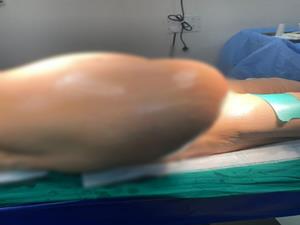
Bengaluru Doctors Treat 63-Year-Old Woman With Over 10 Cm Large Hernia
A hernia is a medical condition where a portion of an organ, typically the intestine, is displaced and protrudes through a weakened area in the abdominal wall.
This protrusion can lead to discomfort, pain, and possible complications if left unaddressed.
The woman presented to Ramakrishna Hospital in Bengaluru had a complicated medical history, encompassing obesity, long-standing asthma, hypertension, and diabetes mellitus.
She also presented with symptoms of pain, vomiting, and bowel dysfunction persisting for two days.
A CT scan revealed that the patient had experienced a significant reduction in abdominal space (loss of domain), with the hernia occupying approximately 40 per cent of the remaining abdominal cavity.
Furthermore, signs of intestinal obstruction were identified, as evidenced by dilated small bowel loops. The hernial orifice was notably large, measuring over 10 cm.
Remarkably, the patient had been aware of the presence of a sizable incisional hernia for nearly a decade, noting its progressive enlargement over time.
"An incisional hernia is characterised by the displacement of part of an organ through a weak point in the abdominal wall, often involving the intestine, at the site of previous surgery. When the hernial defect exceeds 10 centimetres, it is termed a giant or massive hernia. As these hernias enlarge, other organs may protrude as well, leading to a decrease in the abdominal cavity's size and a condition known as 'loss of domain'," Dr. Rajeev Premnath, Laparoscopic Surgeon and Endoscopist at the Hospital told IANS.
"Loss of domain presents challenges to surgeons due to the associated respiratory distress caused by pressure on the lungs," he added.
Given the complexity and risks involved, a multidisciplinary team opted for surgical intervention following discussions with the patient and her family. "The surgical approach included an open abdominal procedure, incorporating hernia repair with mesh placement alongside abdominoplasty to address excess skin. To mitigate risks linked to general anaesthesia, the surgery was conducted under spinal and epidural anaesthesia," Dr. Premnath said.
Following the surgery, several interventions were employed, including non-invasive ventilation to manage respiratory distress resulting from the diminished abdominal space.
In addition, physiotherapy was administered to enhance respiratory function and mitigate potential complications such as atelectasis.
The doctors also diligently managed her underlying medical conditions, including diabetes, hypertension, and asthma.
"After a two-week hospitalisation, the woman regained mobility independence and was discharged in satisfactory condition," said the doctor.
"I am thankful for the care and attention provided by the doctor and the team during my hospital stay. The surgery and postoperative care greatly contributed to my improved mobility, and I am satisfied with the outcome," said the patient.
–IANS
rvt/pgh

Legal Disclaimer:
MENAFN provides the
information “as is” without warranty of any kind. We do not accept
any responsibility or liability for the accuracy, content, images,
videos, licenses, completeness, legality, or reliability of the information
contained in this article. If you have any complaints or copyright
issues related to this article, kindly contact the provider above.


















Comments
No comment